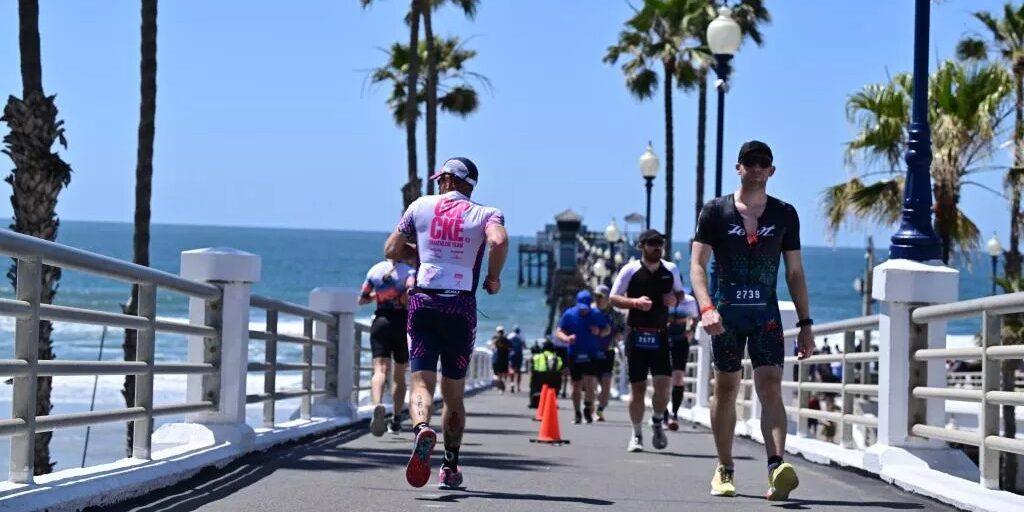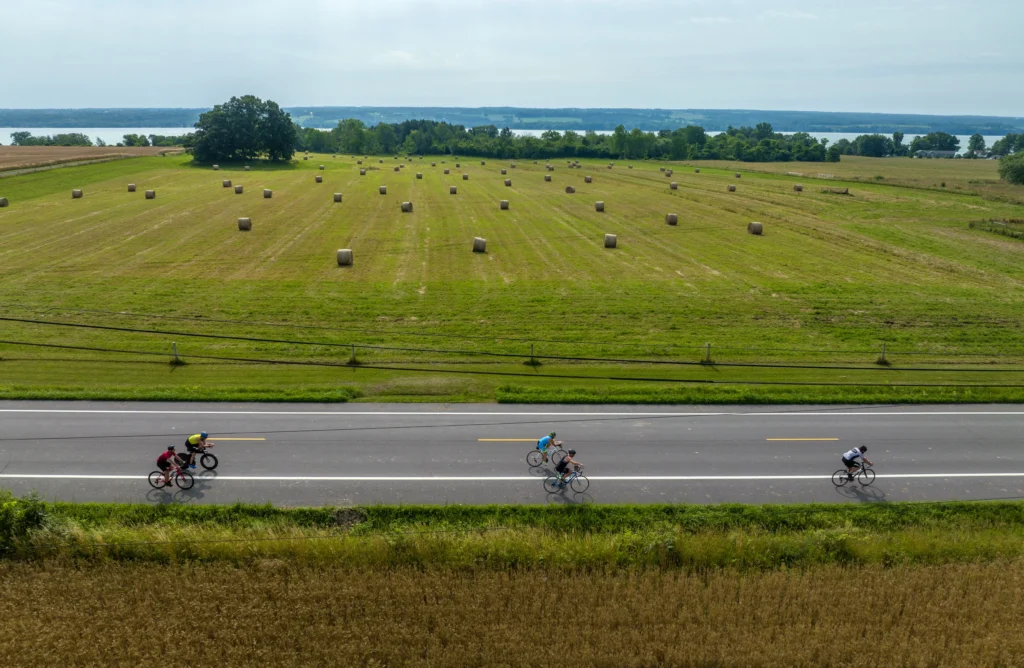I Took On an Ironman 70.3 — Here’s How It Went

Curious if an Ironman 70.3 is within reach for the everyday endurance athlete? Here’s what it takes to complete the race, from start to finish
All products featured on Athletech News are independently selected by our editors. However, when you buy something through our retail links, we may earn an affiliate commission.
For many athletes, completing an Ironman race is a lifelong goal. That energy was palpable at the starting line of the Musselman Ironman 70.3 race in Geneva, New York. Family members gathered at the swim start, just to see their loved ones dive in the water and swim towards the finish line that many would reach more than 5 hours later, holding signs encouraging the future “Ironmen” and “Ironwomen.”
The Ironman Group was founded in 1977 by Judy and John Collins, a couple who founded a triathlon event in Hawaii that would total 140.6 miles. Their big dream was that the triathlon would be an annual event. In the half-century since its inception, there are now more than 150 races around the world, including both full-distance Ironman and half-distance Ironman 70.3 events. For full distance races, competitors complete a 2.4-mile swim, a 112-mile bike ride and a 26.2-mile run, and half those distances in the 70.3 races.
After hearing rave reviews about Ironman races from athletic friends, I became curious about the organization and the race. As a former swimmer and a chronic runner, I wondered if the race would be accessible for a general endurance athlete. I decided to give the race a try and learn about the experience of training for and completing an Ironman 70.3.
Getting Prepared
Preparing for the Ironman 70.3 began as many athletic events begin: with googling and asking those more experienced than me about the training process. First, I knew I needed a reliable and accessible training schedule and system to make my life easier. I became acquainted with TriDot, an AI-powered triathlon platform. As a longtime distance runner, I have tried many different training platforms to prepare for half-marathons and triathlons. But none quite compared to TriDot, which was extremely user-friendly and comprehensive. On TriDot, you can choose between an AI coach and a real coach to guide your training experience. The app is an official Ironman partner and ranges from $39/month (essentials) to $399/month (premium). The AI-person is likely best for those with triathlon experience, while the Coach could be great for beginners or those with specific time goals.
What I loved most about TriDot was how easily customizable it was. After doing some fitness tests, like a timed swim, bike and run to assess my best goals for the race, I was given a training plan for my upcoming race. Because it isn’t always easy to access a pool, or long bike rides may be difficult to plan one’s week around, the schedule was simple to change and personalize. The user experience was beautiful and simple and my coach followed my progress.
One feature I loved was that the workouts immediately appeared on my Garmin Forerunner 970 and were extremely easy to follow, from interval runs to hours-long cycling workouts. During and after each workout, I had a clear idea of my progress. One small feature that I found a little frustrating was that when the workout connected to Strava, instead of defaulting to showing your results in miles or kilometers, it tracked your progress based on the distance of the workout interval (for example, a 1.5-mile stretch). Other than that, the app was easy to use and integrate into day-to-day training.
Next, I knew I needed to get prepared for the cycling portion. I had much of the gear I needed for swimming and running, but lacked one of the most important pieces of equipment for an Ironman race: a good bike. So, I found the Quintana Roo X-PR and it did not disappoint.
The Quintana Roo X-PR was the perfect tri-bike, even for a beginner like myself. It was extremely light and aerodynamic, but also sturdy during even my longest rides. The bike was not only sleek and beautifully designed, but it was also equipped with so many thoughtful features. It has between-the-arm hydration (a straw for easy hydration while racing), a nutrition box that was perfect to grab gels during rides and extremely responsible gear shifts, all housed in a minimalist design. Although its price is still high, at $4,179, it is also an amazing value for its price when it comes to tri-bikes. Many bikes go for closer to $10,000, so the X-PR delivers more quality for less. It also comes in six different sizes and the company offers a Fit-Ready service to double-check your correct armrest extensions, pad risers, saddle setup and more. The brand also offers custom color and build options, but the all-black was still incredibly sleek and beautiful.
The Training
Training for an Ironman 70.3 is no small commitment, but it was also not as daunting as I expected, as someone with a goal of merely finishing. The biggest commitments are swimming once or twice a week and finding the time for long bike rides on the weekends. Iroman recommends a “no-frills” version of their training plan at least two swims, two bikes and two runs per week.
As a complete cycling beginner, I also had to get used to clipping my shoes into the pedals. Although I had done that countless times on a stationary spin bike, getting used to clipping in on the tri bike took a few tries (and some patience from my training buddies). Starting and stopping clipping in and out was the most difficult to get used to (which were admittedly my only falls). But once I did a few longer (30-50-mile) rides and got more gear (padded bike shorts were key), I felt good enough for the race.
My swimming training was also made much easier by a few good tools. As a former swimmer, I grew up training without any gadgets: just a suit, goggles and my thoughts. Today, I have a new appreciation for all the tech that can make hours of laps go by so much faster. While you can’t listen to any music during the actual race, my H2O Audio Tri 2 Pro Multi-Sport Headphones and my Shokz OpenPro Swim headphones made the laps go by so much faster. I also loved wearing my Form Smart Swim 2 goggles (which I saw many competitors use during the race, as well). The Smart Swim 2 goggles are perfect for athletes who want a live feed of data about their swim workouts while in open water or a pool. The goggles automatically track your stats as you swim, displaying a screen inside the lens of the goggles. It shows you heart rate, pace, stroke rate, time, distance and calories burned. The goggles are USA Triathlon and British Triathlon-approved. One amazing feature is that you can snap a picture or type up your swim workout and have the goggles display it live on the inside of your goggles as you swim. Long gone are the days of bringing a soggy workout sheet to the pool deck.
As a runner, I found that the mileage required for the training was accessible but merely required a slightly longer run (more than 10 miles) every other week. One huge difference, however, was practicing the transition from the bike to the run. After a long ride, your legs feel like rubber, so getting that transition down is key for beginners.
Before the Race
Before the race, I also wanted to ensure I had all the right gear for race day. I found an affordable tri-suit on Amazon that I thought was a great value and functioned perfectly on race day. I bought a wetsuit, as well, but my race became wetsuit-optional (more on that later).
In terms of nutrition, I knew I needed good gels, so I brought two packages of Cliff Bloks and two Chargels to the race. I figured they would have electrolytes on the course, but in retrospect, bringing my own for the cycling portion would have been useful.
I began to eat more carbs and tapered several days before the race. The night before the race, I ate a large dinner that was mainly protein and carbs, minimizing anything that could potentially upset my stomach, like indulgent or spicy foods. The morning of the race, I ate a protein bar and a banana.
Ironman makes competitors get to the race at least a day early to drop off their bikes and strongly recommends the race brief. While I missed mine due to traffic by just 30 minutes, I was grateful to be connected with Doc Golden from the Empire Tri Club, who passed along the extremely thorough briefing that the organization provided. It was incredibly helpful to have a thorough idea of where to preserve my energy and attention for safety and performance. She passed along where the biggest hills were, where there were steep downhills (for safety purposes), as well as how best to consume my nutrition throughout the race. With the briefing and her advice, I felt far more prepared going into the race.
Race Day
By the time competitors get to race day (for me, at the early hour of 5:45 am, for a 7 am start), the hard work is done. One thing that I appreciated about the Ironman 70.3 race was the incredible community and the well-organized staff on site. Not being able to listen to music during the race fostered an extremely collaborative and supportive community. I must have had over 50 competitors encourage me during the race (particularly on the cycling section, where I was fairly inexperienced). The water was relatively clean and warmer than expected, with only minimal debris in the lake. The cycling course in Musselman was absolutely stunning: miles and miles through lush vineyards and rolling hills, which made the hours fly by faster. The run course was through the town and by the water, and even though it was two similar loops, it was made better by the large crowds cheering on the competitors.

credit: Donald Miralle / Ironman
During the transitions, athletes cheered for each other, offered help (a competitor offered to help me put on my bib when he noticed my hands were still hurting from gripping my cycling handbars for so long) and commiserated. My particular race was extremely hot, with temperatures close to 90 degrees, which is also why the race was wetsuit optional (which meant that if you wore a wetsuit, you started later and could not qualify for Worlds). When several competitors needed to drop out due to overheating, I saw athletes stop and help each other and provide emotional support. I also saw the organization step in quickly and effectively to help those in need. The organization seemed like a well-oiled machine that was very prepared to carry out the race efficiently and effectively, with competitors’ health a first priority.
At the finish line, spirits were higher than I had ever seen at a race. During the finish line photo op, the couple in front of me got engaged, for which the crowds cheered. I saw many triathlon clubs (including the Empire Tri Club), gather and celebrate, or cheer their participants on until the final competitors crossed the finish line. One other surprising feature of the race was the sheer range of demographics, from the elderly to the young, to all shapes and sizes. Unlike many other races, there seemed to be less of a focus on finish time (except at some of the higher levels) and more on the experience.
Overall, I highly recommend an Ironman 70.3 to any endurance athlete, even one who may doubt their abilities to complete one of the three legs of the race. If you’re willing to invest in some gear and spend the time training for the race, run (bike, or swim) to sign up for an Ironman 70.3.



